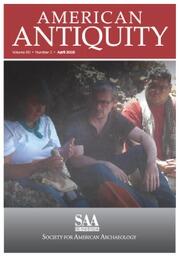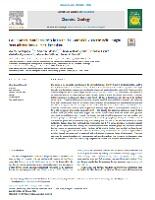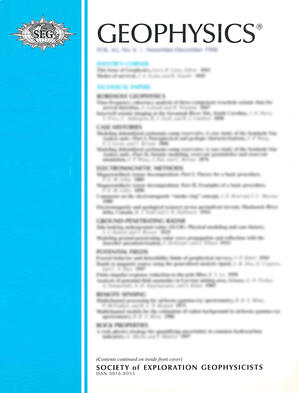Williams-Jones, Glyn
Person Preferred Name
Glyn Williams-Jones
Related Works
Content type
Digital Document
Abstract
Among Líĺwat people of the Interior Plateau of British Columbia, an oral tradition relays how early ancestors used to ascend Qẃelqẃelústen, or Mount Meager. The account maintains that those climbers could see the ocean, which is not the case today, because the mountain is surrounded by many other high peaks, and the Strait of Georgia is several mountain ridges to the west. However, the mountain is an active and volatile volcano, which last erupted circa 2360 cal BP. It is also the site of the largest landslide in Canadian history, which occurred in 2010. Given that it had been a high, glacier-capped mountain throughout the Holocene, much like other volcanoes along the coastal range, we surmise that a climber may have reasonably been afforded a view of the ocean from its prior heights. We conducted viewshed analyses of the potential mountain height prior to its eruption and determined that one could indeed view the ocean if the mountain were at least 950 m higher than it is today. This aligns with the oral tradition, indicating that it may be over 2,400 years old, and plausibly in the range of 4,000 to 9,000 years old when the mountain may have been at such a height.
Origin Information
Content type
Digital Document
Abstract
Geothermal exploration relies in part on the gas geochemis- try of fumaroles, bubbling springs and steaming ground to offer insight into the nature of the fluids at depth, processes affecting them when rising to the surface, and provide estimates of the temperature of last equilibration of the gases within the reservoir. Traditional measurements involve direct sampling of the gases in pre-evacuated Giggenbach glass bottles before laboratory chemical analysis. Gas component analysis, combined with the isotope ratios of certain components (e.g., CO2, He), provides insight into the proportion of magmatic, crustal, meteoric and atmospheric components in the fluid, and the state of equilibrium and temperature of these fluids at depth.
The Multi-component Gas Analyzing System (MultiGAS) was developed by the volcanological community over 10 years ago as a field-portable instrument for in-situ analysis of the major volcanic gas components in diffuse and dilute gas emissions. No two instruments are identical but all consist of various sensor types now capable of simultaneously analyzing for H2O, CO2, CO, SO2 and H2S.
In geothermal systems, surface manifestations are often com- prised of gas emissions. In some cases, low temperatures and/or low flow rates make traditional sampling of fumaroles difficult, due to rapid vapor condensation (in water-rich fumaroles) and atmospheric contamination. The MultiGAS is best suited to these types of manifestations, providing a tool that can be used at a wide variety of locations with differing gas emission styles.
The MultiGAS has been field-tested in two very different geothermal prospect areas: one characterized by cold, CO2-rich gas seeps and bubbling springs, and the other characterized by steaming ground and fumaroles with temperatures near the boiling point of water. Results of the MultiGAS analysis are compared with the equivalent ratios obtained from traditional sampling and
analytical procedures (where possible), in order to identify the ad- vantages and disadvantages of this new technique. The MultiGAS allows for the rapid characterization of the gas geochemistry in the field, aids in mapping/targeting of fumaroles in a large field, and allows for the selection of the most ideal fumaroles to sample using the traditional Giggenbach method.
Origin Information
Content type
Digital Document
Abstract
The nature of the magmatic source beneath the Garibaldi Volcanic Belt (GVB) in NW Washington (USA) and SW British Columbia (Canada) has been debated both due to its classification as the northern equivalent of the High Cascades and the alkaline nature of northern basalts. Whole rock studies have shown that the GVB does not share the same magmatic source as the High Cascades (Mullen and Weis, 2013, 2015). Nonetheless, the presence of alkaline basalts in this arc raises questions about the exact source of mantle enrichment and whether it is related to the young age of the downgoing Juan de Fuca Plate (< 10 Ma) or the presence of a slab tear at the northern end of the arc. To gain insight into the source that underlies the GVB, we sampled olivine-hosted melt inclusions from each volcanic centre along the arc. Major, volatile and trace element data reveal a northward compositional trend from arc-typical calc-alkaline magma in the south to OIB-like melts in the north near the slab tear. Furthermore, contributions from the subducting slab are relatively high beneath the southern end of the arc (Cl/Nb> 80) but rapidly decreases to the north (Cl/Nb < 50). Finally, the significant differences in Zr/Nb from south to north (80 and 9, respectively) suggest two distinct mantle sources since one source cannot produce melts with such different ratios. As such, we propose the GVB should be segmented into the Northern and Southern groups, each having its own mantle source. Based on the geographic proximity, the enriched nature of the Northern group melt inclusions is likely controlled by the slab tear at the northern termination of the subducting Juan de Fuca Plate. Melt modelling results show that 3–7 % partial melting of the primitive mantle with a garnet lherzolite residue can reproduce the composition of the Northern group. Melt inclusions from the Southern group, on the other hand, imply a depleted MORB mantle that has been modified by fluids derived from the downgoing slab. Variability within the Southern group itself reflects the amount of hydrous fluids supplied beneath each centre and is correlated with slab age and subsequent degree of dehydration. This study addresses the compositional diversity along the arc and provides evidence that the age of the downgoing plate and the presence of a slab tear exert a strong compositional control over eruptive products within one arc.
Origin Information
Content type
Digital Document
Abstract
Las Sierras-Masaya volcanic system is a persistently active basaltic caldera complex in Nicaragua. While there has been almost no juvenile material erupted since 1772, Masaya volcano has been persistently degassing for >150 years. An additional unusual behaviour for the Las Sierras-Masaya volcanic complex is its ability to produce large caldera-forming basaltic Plinian eruptions with the most recent occurring about 1800 years ago.
Here we present melt inclusion analyses that provide constraints on the magmatic system over time. Melt inclusions hosted in plagioclase and olivine crystals were analyzed for major, trace and volatile elements (S, Cl, F, H2O). The data supports a consistent parental magmatic source with restricted compositional variability explained by simple fractional crystallization of plagioclase, olivine, clinopyroxene and magnetite at a nearly constant temperature. This broadly agrees with previous whole rock geochemical studies showing that the overall chemical signature of volcanic products at Masaya has remained largely unchanged for ~60,000 years and that both shallow fractionation and degassing processes dominate the whole evolution of the magmatic series. Based on volatile element in melt inclusions and gas composition and flux measurements, we determine the magmatic flux to be ~0.19 km3 yr−1 implying that up to 47 km3 of magma may have degassed since the last effusive eruption. As at other persistently active basaltic volcanoes (e.g., Mt. Etna, Italy; Kilauea, Hawaii, USA), this magmatic flux must involve significant endogenous storage which is likely accommodated by extensional tectonics. However, Masaya volcano differs in its apparent simplicity with respect to its stable chemistry and its fully interconnected magmatic system.
Origin Information
Content type
Digital Document
Abstract
[1] Subduction zone recycling of volatiles (H2O, Cl, S, F) is controlled by the nature of subducted materials and the temperature‐pressure profile of the downgoing slab. We investigate the variability in volatile and fluid‐mobile trace element enrichment in the Sunda arc using melt inclusion data from Kawah Ijen and Tambora volcanoes, together with published data from Galunggung, Indonesia. Combining our results with data from other arcs, we investigate the mobility of these elements during slab dehydration and melting. We observe correlations between Sr, H2O and Cl contents, indicating coupling of these elements during subduction zone recycling. Sulfur is more variable, and fluorine contents generally remain at background mantle values, suggesting decoupling of these elements from H2O and Cl. Partial melting and dehydration models constrain the source of Sr and the volatiles and suggest that the altered oceanic crust (AOC) is the main source of the hydrous component that fluxes into the mantle wedge, in agreement with thermo‐mechanical models. Sediment melt remains an important component for other elements such as Ba, Pb, Th and the LREE. The Indonesian volcanoes have variable concentrations of volatile and fluid‐mobile elements, with Kawah Ijen recording higher AOC‐derived fluid fluxes (Sr/Nd and H2O/Nd) compared to Galunggung and Tambora. Kawah Ijen has H2O/Ce ratios that are comparable to some of the most volatile‐rich magmas from other cold slab subduction zones worldwide, and the highest yet measured in the Sunda arc.
Origin Information
Content type
Digital Document
Abstract
This thesis characterizes the transfer of magmatic volatiles through the mantle and the crust to the atmosphere through the integration of melt inclusion data for pre-eruptive volatile contents with surface measurements of volcanic degassing (recorded in micro-gravity changes and volcanic fumarole and plume gas compositions) at two contrasting volcanoes: Sierra Negra, Galápagos Islands and Kawah Ijen, Indonesia. In particular, it explores the process of fluid transfer in the mantle, the partitioning of volatile elements during mantle melting and degassing of the magma through the crust, and the effect of near-surface (e.g., interactions with groundwater and hydrothermal fluids), and surface processes (e.g., cooling and mixing with air) on the gas species. The effects of differences in initial volatile content and internal volcano structure on the types of eruptions and emissions recorded at each volcano are also discussed. The comparison of Sierra Negra and Kawah Ijen volcanoes reveals that differences in style of volcanic activity are primarily a function of magmatic plumbing system as opposed to differences in initial volatile content. In both cases, permeability of the crust and degassing style have exerted a dominant control over the recent style of activity (last century). Recent eruptions at Sierra Negra are not necessarily associated with magma recharge into shallow reservoirs but can be caused by subtle changes in the pressure regime of a magma chamber, a process which is closely associated with degassing and system permeability. Large explosive eruptions at Kawah Ijen are currently impeded by the open system (permeable) flow of magma and gas through the plumbing system. Hydrothermal systems play an important role in controlling the permeability of a system and the composition of the gases measured at the surface. The comparison of theoretically modeled gas compositions with actual measured compositions is an effective approach to studying the influence of hydrothermal systems at open vent volcanoes.
Origin Information
Content type
Digital Document
Abstract
Sierra Negra volcano, the most voluminous shield volcano in the Galápagos archipelago and one of the largest basaltic calderas in the world, erupted on October 22, 2005 after more than 25years of quiescence. GPS and satellite radar interferometry (InSAR) monitoring of the deformation of the caldera floor in the months prior to the eruption documented extraordinary inflation rates (1cm/day). The total amount of uplift recorded since monitoring began in 1992 approached 5m at the center of the caldera over the eight days of the eruption the caldera floor deflated a maximum of 5 m and subsquently renewed its inflation, but at a decelerating rate. To gain insight into the nature of the subsurface mass/density changes associated with the deformation, gravity measurements performed in 2005, 2006, and 2007 are compared to previous measurements from 2001-2002 when the volcano underwent a period of minor deflation and magma withdrawal. The residual gravity decrease between 2001-2002 and 2005 is among the largest ever recorded at an active volcano (−950 μGal) and suggests that inflation was accompanied by a relative density decrease in the magmatic system. Forward modeling of the residual gravity data in 4D (from 2002 to 2005) gives an estimate of the amount of vesiculation in the shallow sill required to explain the observed gravity variations. Geochemical constraints from melt inclusion and satellite remote-sensing data allow us to estimate the pre-eruptive gas content of the magma and place constraints on the thickness of the gas-rich sill necessary to produce the gravity anomalies observed. Results suggest that reasonable sill thicknesses (700–800m) and bubble contents (10–50 volume %) can explain the large decrease in residual gravity prior to eruption. Following the eruption (2006 and 2007), the deformation and gravity patterns suggest re-equilibration of the pressure regime in the shallow magma system via a renewed influx of relatively gas-poor magma into the shallow parts of the system.
Origin Information





